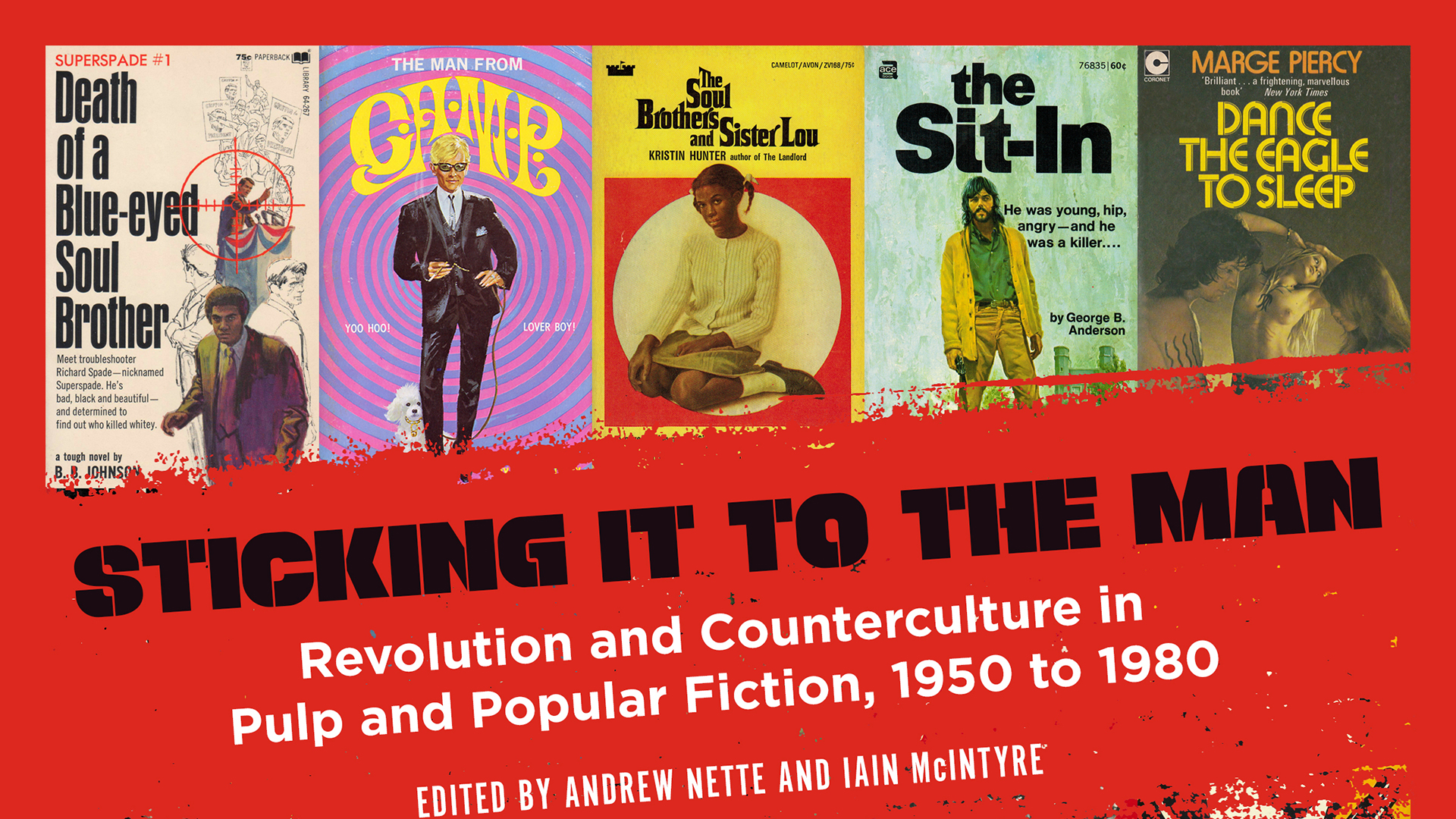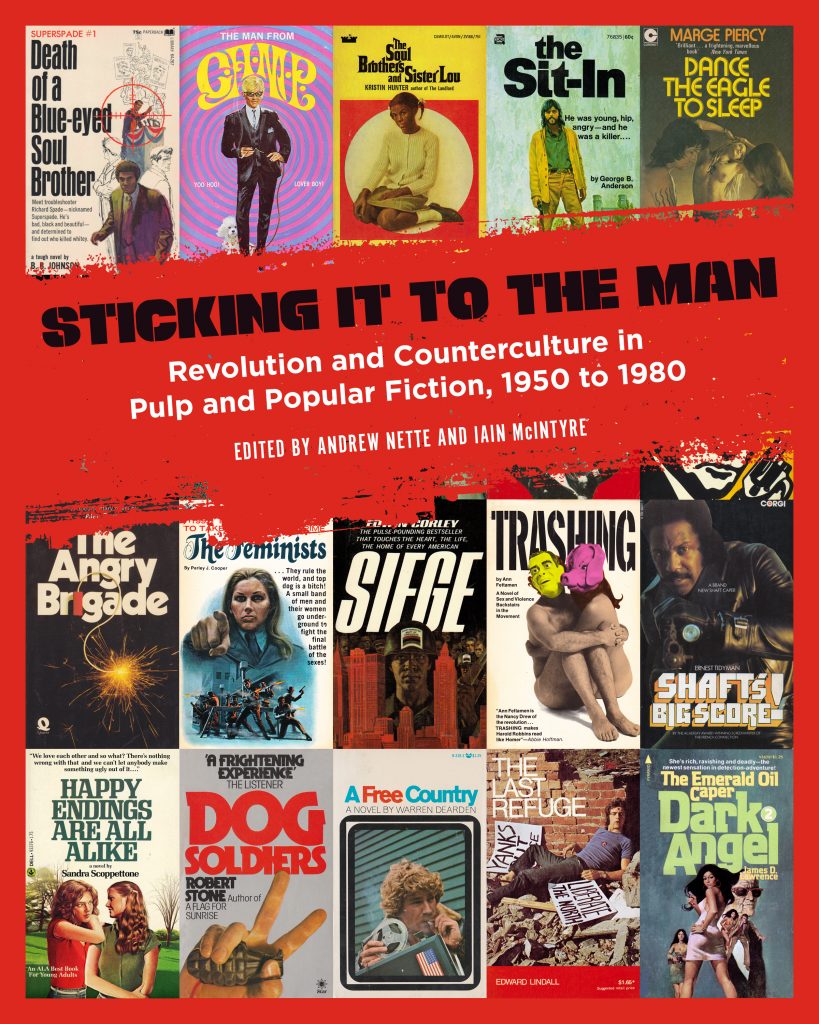By Michael Jongen
The Newton Review of Books
January 30th, 2020
Sticking it to the Man brings together a wide-ranging collection of essays that examine how the counterculture and radical politics have been reflected in popular fiction.
In this new book, Nette and McIntyre have produced a companion volume to Girl Gangs, Biker Boys, and Real Cool Cats, their study of pulp fiction and youth culture. Sticking it to the Man takes its cue from themes of revolution and counterculture in the period 1950 to 1980. This collection of essays from 26 contributors examines overlooked novels and authors and explores how pulp fiction portrayed radicalism and the shifting social climate.
The sixties were also the time of the paperback boom, which gave many writers from marginalised communities opportunities to have their work published. This book is both a celebration and a snapshot of the period and its radical politics, encompassing the civil rights movement, Black Power, anarchists, Maoists, Weathermen and Yippies. The growing gay liberation movement is also represented. As Nette and McIntyre write in their introduction:
These novels not only reflected their times but also shaped them, providing new opportunities to air and explore progressive ideas or, alternatively, to ridicule and oppose them. The challenges posed in much of the fiction covered in this book increased as the years rolled on and the ranks of working novelists were swelled by active participants of the long sixties’ political and cultural ferment.
Over 350 covers have been reproduced, and the editors promise that the majority of the books are entertaining, although some are curios that have been included for a single memorable or amusing paragraph.
The reader is treated to a marvellous collection of essays covering remarkable and obscure cultural pulp fiction and placing it beside the historical events and politics of the era. It celebrates lowbrow art as surely and lovingly as John Waters.
Sticking it to the Man has essays on Chester Himes, creator of the Harlem Detective series; the Superspade novels of Joseph Perkins Greene (published under the pen-name BB Johnson); and Shaft by Ernest Tidyman. ‘The cool, the square, and the tough’ examines the archetypes of black male characters. There are essays on the depiction of campus revolts, the allure of the street, violent political groups, feminism, gay and lesbian liberation, and middle-class revolutionaries.
Suzie Thomas’s essay on ER Braithwaite’s To Sir, with Love reminds us of the films associated with more than a few of the publications mentioned, Death Wish and In the Heat of the Night among them.
Australian writing and publishing in this era is well covered. Nette’s interview with Andrew Gold, publisher of Gold Star Publications, is fascinating, particularly for his account of the importation of The Little Red School Book in 1972 after it was banned in some states:
‘… the serious conservatives in the states, particularly Queensland, decided to use it as a dividing line. So it was banned in Queensland, banned in New South Wales, and I think it was banned under state legislation in Victoria too. But [Minister for Customs and Excise] Chipp refused to ban it for importation into the country, so it could be imported legitimately. We bought it in and published it. The fact was, the majority of adults thought banning it was a ridiculous move. It actually broke the back of censorship, that book. They picked the wrong fight.’
David Whish-Wilson’s essay ‘Resilience and Representation’ looks at portrayals of Aboriginal Australians in pulp and popular fiction, including Arthur Upfield’s Detective Inspector Napoleon ‘Bony’ Bonaparte novels, published between 1929 and 1966, the creation of an Englishman who arrived in Australia in 1911, fought in the Australian Imperial Forces at Gallipoli and lived most of his life in the Australian bush. Colin Johnson’s Wild Cat Falling paints a much more authentic picture of the life of an Indigenous teenager, opening as the anonymous narrator is released from prison.
The prolific Frank Clune published a pulp biography of Jimmy Governor, whose story became better known through the novel The Chant of Jimmie Blacksmith by Thomas Keneally; Keneally has since said he regretted using an Indigenous POV character. Archie Weller’s novel The Day of the Dog and the films Walkabout and Journey Among Women are also covered. This is a sobering look at the stereotyping and racism experienced by Indigenous Australians, as well as a history of the early publishing of Indigenous authors and their stories.
The history of gay and lesbian books is well covered, and we can see a shift in the culture from City of Night by John Rechy, published in 1963, to Patricia Nell Warren’s The Front Runner from 1974. Jenny Pausacker’s essay, first published in 1981, about young adult ‘problem’ novels that dealt with adolescent homosexuality, charts this transition. Many of these novels gave young gay people visibility, but publisher pressure and public morality meant that, although the discussion of homosexuality had opened, a happy ending was not expected or required:
The propaganda of these books was very aptly pitched at adolescents questioning their sexuality. To show homosexuality as totally unattractive would have invited disbelief, so the authors first offered the charismatic beloveds of the male homosexual books and the powerful feelings of the lesbian novels, before using coincidence or letdowns to say, ‘However, it’s not possible,’ and rounding off the exercise with the spurious consolation, ‘It’s only a phase.’
The Vietnam War provides a backdrop to many of the stories in the world of pulp fiction. In his essay ‘Blowback’, Nette argues that the war’s traumatic impact on America enabled pulp and popular fiction writers to explore cultural fragmentation and chart the decline of the American Dream.
We live in an age when many who grew up in this period are now maligned as Boomers, and reading this book may make us wonder why the promise of the progressive ideals of this generation failed to materialise. It’s interesting that this era, 1950 to 1980, corresponds to that covered by Thomas Piketty’s research on economic inequality, which found that it was a period when economic equality rose after World War II before beginning to decline again in the late seventies. This book reminds us of who we were before the decade of greed and style led to unfettered capitalism once again.
There is much enjoyment and reflection to be had from this discussion of marvellous books and their cover images.
Andrew Nette and Iain McIntyre (Eds) Sticking it to the Man: Revolution and counterculture in pulp and popular fiction 1950 to 1980 PM Press 2019 PB 336pp $63.99
Michael Jongen is a librarian who tweets as @michael_jongen







